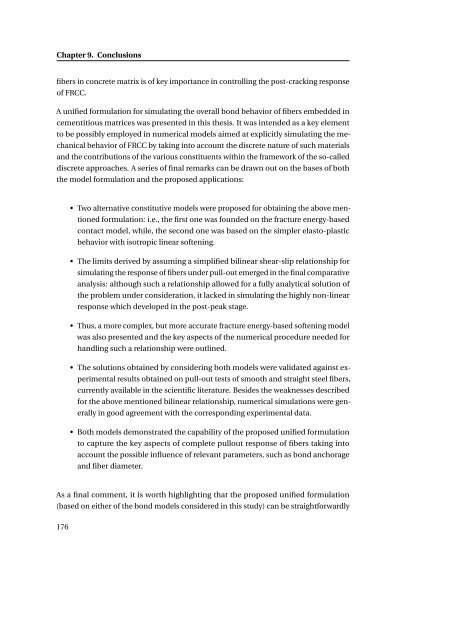tesi A. Caggiano.pdf - EleA@UniSA - Università degli Studi di Salerno
tesi A. Caggiano.pdf - EleA@UniSA - Università degli Studi di Salerno
tesi A. Caggiano.pdf - EleA@UniSA - Università degli Studi di Salerno
- No tags were found...
You also want an ePaper? Increase the reach of your titles
YUMPU automatically turns print PDFs into web optimized ePapers that Google loves.
Chapter 9. Conclusionsfibers in concrete matrix is of key importance in controlling the post-cracking responseof FRCC.A unified formulation for simulating the overall bond behavior of fibers embedded incementitious matrices was presented in this thesis. It was intended as a key elementto be possibly employed in numerical models aimed at explicitly simulating the mechanicalbehavior of FRCC by taking into account the <strong>di</strong>screte nature of such materialsand the contributions of the various constituents within the framework of the so-called<strong>di</strong>screte approaches. A series of final remarks can be drawn out on the bases of boththe model formulation and the proposed applications:• Two alternative constitutive models were proposed for obtaining the above mentionedformulation: i.e., the first one was founded on the fracture energy-basedcontact model, while, the second one was based on the simpler elasto-plasticbehavior with isotropic linear softening.• The limits derived by assuming a simplified bilinear shear-slip relationship forsimulating the response of fibers under pull-out emerged in the final comparativeanalysis: although such a relationship allowed for a fully analytical solution ofthe problem under consideration, it lacked in simulating the highly non-linearresponse which developed in the post-peak stage.• Thus, a more complex, but more accurate fracture energy-based softening modelwas also presented and the key aspects of the numerical procedure needed forhandling such a relationship were outlined.• The solutions obtained by considering both models were validated against experimentalresults obtained on pull-out tests of smooth and straight steel fibers,currently available in the scientific literature. Besides the weaknesses describedfor the above mentioned bilinear relationship, numerical simulations were generallyin good agreement with the correspon<strong>di</strong>ng experimental data.• Both models demonstrated the capability of the proposed unified formulationto capture the key aspects of complete pullout response of fibers taking intoaccount the possible influence of relevant parameters, such as bond anchorageand fiber <strong>di</strong>ameter.As a final comment, it is worth highlighting that the proposed unified formulation(based on either of the bond models considered in this study) can be straightforwardly176
















